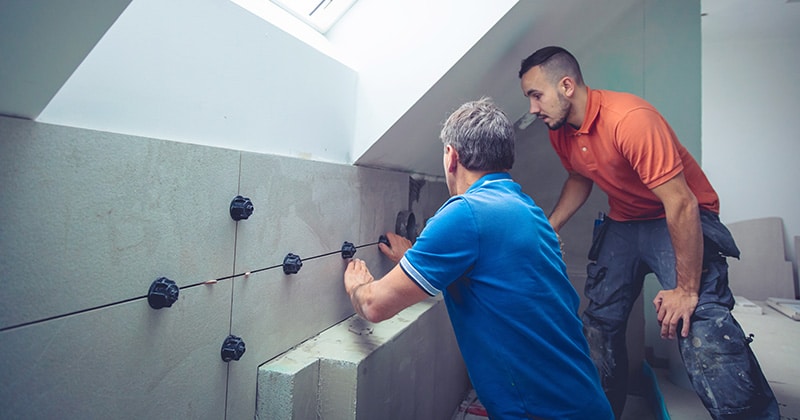Getting paid weeks—even months—after a job just doesn’t work.
Your cash flow suffers, which makes it hard to keep on top of your expenses. You can’t get the supplies you need. Suddenly, your next project must be pushed back.
You’re behind, and the stress is all too real.
Let’s put an end to this right here, right now.
In this guide to getting paid faster, we’ll explain why quick invoicing should be at the top of your priority list. We’ll explore the benefits of using a home improvement invoice template before defining the key elements.
Next, we’ll get right to the meat and potatoes. We have a home improvement invoice template that every single remodeler needs. It’s professional and easy to use.
Finally, we’ll tie it all up with our quick takeaway tips. These are all about maximizing your cash flow with an efficient invoicing process.
Let’s get started!
RELATED ARTICLE: Remodeling & Home Improvement Estimate Template
The Importance of Efficient Invoicing for Remodelers
Invoicing is so much more than just another task to check off your to-do list. It’s integral to your business’s momentum.
Think about it like this: Cashflow keeps your business moving forward. It’s like the fuel that helps projects stay on track.
According to Investopedia: “Assessing cash flows is essential for evaluating a company’s liquidity, flexibility, and overall financial performance.”
Delayed invoicing means disrupted cash flow. And when every dollar matters, this can lead to big headaches like:
- Fractured supplier relationships. Late payments can hurt your reputation. It gets harder to buy materials on time or on credit.
- Project delays. You can’t start or continue work on the next project if you don’t have the funds to cover it.
- More time spent on tedious admin tasks. Chasing late payments adds more hours to your day. These hours must come from somewhere. Often, it’s customer care or service quality that suffers.
- Lost trust. Waiting too long to bill clients can confuse them. They might see your business as unprofessional. They might not want to work with you again.

The Benefits of Using Home Improvement Invoice Templates
It’s not rocket science. You want to avoid those setbacks listed above—your long-term success depends on it.
But, at the end of the day, invoicing is no one’s favorite part of the job. The easier you can make the process, the better.
Of course, this doesn’t mean cutting corners. Mistakes are a big no-no when it comes to payments and billing.
You need a solution that’s quick to execute and always results in accurate, effective, and professional invoices. Enter the home improvement invoice template.
If you’re creating every invoice from scratch, a template can make your life a whole lot easier. Here’s why it’s worth making the switch:
- You don’t have to start from a blank page every time. It saves you time and makes sending invoices faster.
- A pre-made template means less room for error. You won’t forget important details.
- A clean, well-structured invoice shows clients you care about clear communication.
- A consistent invoice format makes it easier to track when payments are due. You can then follow up on outstanding balances.
- A good invoice template includes all the necessary details. This can help you maintain compliance with relevant rules or regulations.
- Faster, more accurate invoices lead to quicker payments. This translates to more reliable cash flow for your business.
FROM ONE OF OUR PARTNERS: The 8 Best Construction Estimating Software Solutions
Key Elements of an Effective Home Improvement Invoice Template
What does a good home improvement invoice template look like? It must include these key elements.
Clear Identification of Parties Involved
It might sound obvious, but your invoice should include your contact information. Add your company’s name, address, and phone number.
It should also list the client’s name and contact details.
That way, there is zero confusion about who is sending and receiving the bill.
Invoice Number and Date
Every invoice should have a unique number. This helps you keep track of the payment status or find the invoice again in the future.
You should also include the date the invoice was sent.
Description of Services Provided
What are you charging the client for?
Include a breakdown of the work you did and be specific here. You might note that you installed new windows and repaired existing ones. Or that you painted the east side of the home.
The clearer you are, the less likely you’ll run into misunderstandings. The client knows exactly what they’re paying for.
Transparent Breakdown of Costs
Next to each item, write down the cost. You might want to price the service and materials separately.
Either way, transparency builds trust. It also reduces questions or disputes later down the line.
Payment Terms and Due Dates
The client knows what they’re paying for. You also want to address when that payment is due.
There are two ways to go about this:
- The invoice is due on a specific date, like September 30.
- The invoice is due in a set number of days. You might write, “Payment is due within 30 days of receipt.”
Late Payment Fees
Late payment fees might encourage your clients to settle their balance on time.
If you decide to charge late payment fees, mention them on the invoice. Specify how much the fee is and when it will apply if the payment is late.
Payment Methods Accepted
Finally, an effective invoice gives the customer all the information they need to act and pay. This includes how they can pay you.
List the payment methods you accept, like credit card or bank transfer.
Keep in mind it’s best practice to offer a few different payment methods. Each of your customers has their own preferences. The easier you make it for them, the sooner you’ll be paid.

The Home Improvement Invoice Template Every Remodeler Needs
We’ve taken the above key elements and transformed them into a proven invoice template. It’s simple, highly legible, and includes all the details your customers need.
The Ultimate Home Improvement Invoice Template
Company name
Company Address
Phone number
Email address
Website
Invoice # [insert a unique invoice number]
Date: [insert date]
Billed To:
Client’s name
Client’s address
Client’s phone number
Client’s email address
Description of Services Provided:
| Service | Quantity | Unit price | Total |
| [Example: Installation of new windows] | [Insert Qty] | [Insert Price] | [Total] |
| [Example: Exterior painting] | [Insert Qty] | [Insert Price] | [Total] |
Subtotal: $[Add prices above and insert here]
Sales tax (if applicable): $[Insert tax amount]
Total amount due: $[Add the subtotal and sales tax and insert here]
Payment terms: Payment is due within [insert number of days here, e.g., 30 days] from the date of this invoice.
Late payments may incur a [insert percentage here]% fee.
Please pay by:
Credit card (Visa, MasterCard, etc.)
Bank transfer
Check payable to [insert company name here]
[List any other payment methods you accept here]
Please send payment to:
[Add your payment details here, such as your bank account information, etc.]
If you have any questions about this invoice, please reach out to us. We’re here to help.
Thank you for your business!
How to Use the Template
When it comes time to use the template, either download the excel version above or follow this process:
- Personalize the invoice with your company details. Replace all placeholder information. Double-check that everything’s accurate and up to date.
- Pop in the client’s details. If the client is a couple, include both of their names.
- Add descriptions of the services provided. Include details like the quantity, unit price, and total, if applicable.
- Set clear payment terms. Decide what works best for you while giving your client some flexibility.
- Include your accepted payment methods. If you accept online payments, you could add a link in this section, too.
- Proofread before you hit send. Calculate the totals again. Read through the information twice. When you’re sure everything is correct, it’s time to send the invoice.
- Convert it to a PDF. You don’t want to send your invoice in Word or Google Docs format. Create a PDF and attach it to an email.
FROM ONE OF OUR PARTNERS: The 7 Best Invoice Software Options for Small Businesses
Takeaway Tips to Maximize Cash Flow through Efficient Invoicing
Get paid faster with these five takeaway tips:
- Offer multiple payment options. Accept credit cards, bank transfers, and even digital payments like Joist or Invoice Simple. Customers want a friction-free experience that caters to their preferences.
- Use automated invoicing software. Tools like QuickBooks can make it faster to send invoices. They also include automation features, so there’s less manual effort involved.
- Make fast invoicing a habit. Sending an invoice immediately after project completion should be a part of your process. The quicker you bill, the quicker you’ll get paid.
- Use an all-in-one customer relationship management (CRM) solution. A CRM like MarketSharp can streamline your invoicing. It also covers project management and customer communications—all in one place.
- Consider changing your payment terms. Still struggling with slow payments? Review your payment terms. Is the due date clear? Do you charge a late fee? Small tweaks can inspire customers to act fast.

